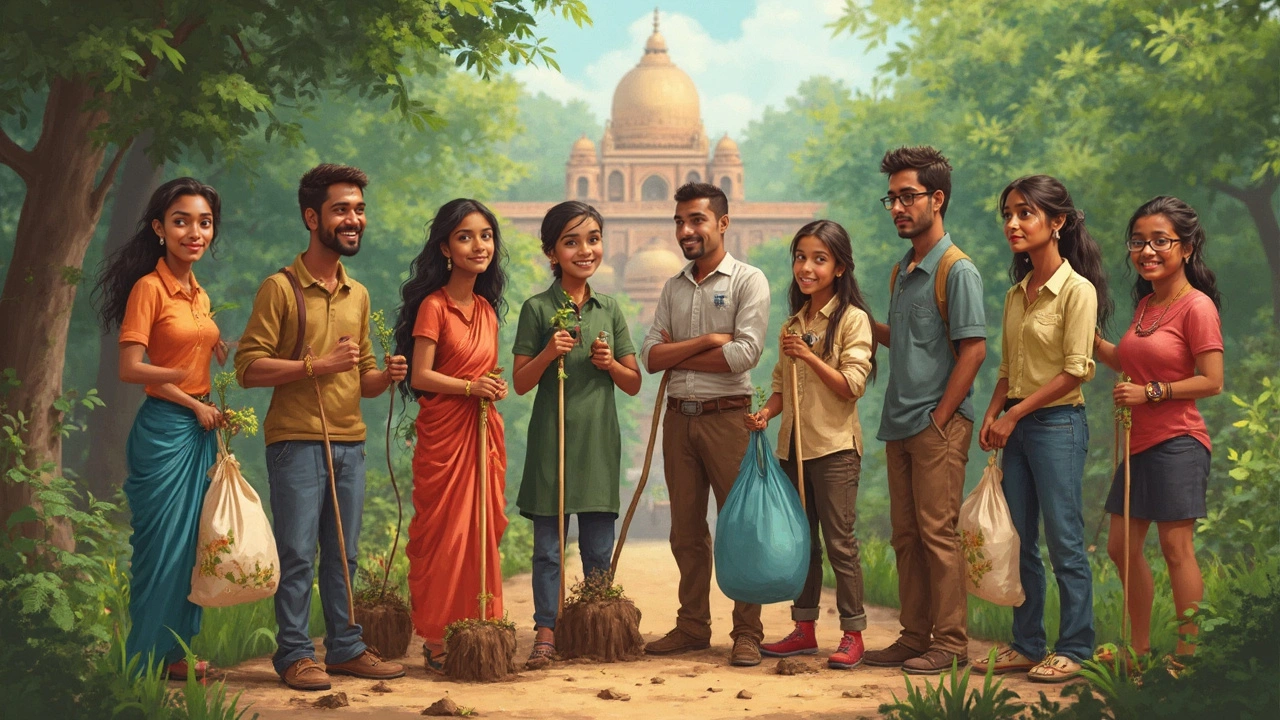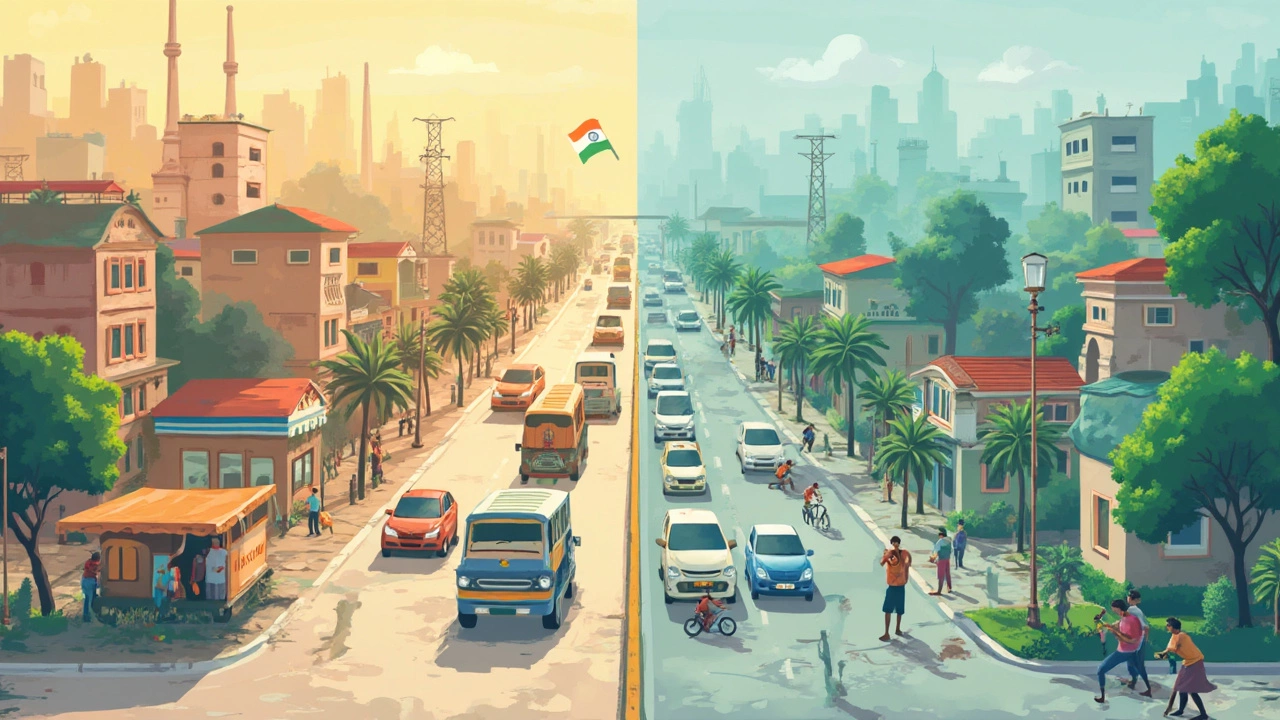What is Your Vision of an Ideal India? Honest Hopes, Real Talk
 Apr, 23 2025
Apr, 23 2025
Ask someone in India about their dream country, and most will rattle off the usual stuff: no corruption, clean streets, better jobs, educated people. Sure, these sound good on paper. But what does that really mean in daily life? How do we go from complaining about potholes to feeling proud of the road we actually built together?
This isn’t about grabbing headlines or chanting slogans for one day a year. It’s about seeing the small, honest hopes people carry, even if they rarely say them out loud. From parents dreaming of schools that teach kids to actually think, to young adults who just want a fair shot without 'connections' or bribes—it’s personal, not just political.
- Dreams Beyond Slogans: What Do People Actually Want?
- Breaking Old Chains: The Real Obstacles
- The Role of Education and Mindset
- Everyday Actions: Small Habits, Big Change
- What an Ideal India Looks Like—Through Real Quotes
Dreams Beyond Slogans: What Do People Actually Want?
People talk about an ideal India almost like it’s a fantasy. But if you listen closely, there’s a pretty clear wish list. Most folks aren’t thinking about winning Nobel Prizes or being the next Silicon Valley. Instead, they’re hoping for basic, straightforward things that make everyday life less painful and more fair.
Let's break it down. Surveys by Pew Research from recent years show that over 60% of Indians say jobs and cost of living are their biggest worries. Safety pops up a lot too, especially for women. Clean water, reliable electricity, and a decent hospital nearby—these are the top priorities. In rural areas, people just want all-weather roads that don’t flood every monsoon. In cities, it’s more about cleaner air and less chaos on the streets.
Here's what people usually dream of—minus the usual politician talk:
- Regular jobs and fair wages without having to pull favors or bribe someone.
- Quality schools that focus on actual learning, not endless rote memorization.
- Healthcare that works—ambulances that show up, hospitals that don’t make people feel like nobody cares.
- Safe streets, especially for women and kids, whether it's daytime or after sunset.
- Basic honesty from those in power—not making dumb excuses for every mess-up.
Here’s a quick look at what people said in a 2024 Mint survey about top changes they want to see:
| Wish | % Top Priority |
|---|---|
| More jobs | 44% |
| Better law & order | 21% |
| Affordable healthcare | 18% |
| Cleaner air and water | 10% |
The idea of the future India isn’t about being “the greatest” or “world’s biggest.” It’s about living with dignity: surviving the traffic, breathing clean air, knowing your kid’s school does more than hand out certificates. The truth? People just want a fair shot at a good life—minus all the drama and shortcuts. That’s the backbone of any vision for an ideal India.
Breaking Old Chains: The Real Obstacles
If we’re honest, the biggest things holding back an ideal India aren’t just broken roads or noisy politics—they’re deep-rooted habits and mindsets. Stuff like favoritism, seeing things through a ‘chalta hai’ (let it be) attitude, or thinking rules are only for someone else. These aren’t new problems. For decades, surveys show over half of Indians think corruption hurts them directly, as reported by Transparency International in 2023.
Poverty is a chain that bites hard. Even in 2025, the numbers don’t lie. The World Bank put India’s poverty rate at around 10% last year. This isn’t just about money—it means less access to decent schools, safe water, and even dignity. Sometimes, people are forced to bribe for basic paperwork because saying 'no' could mean missed opportunities or endless delays.
Caste and class barriers still work like invisible walls. Sure, people talk more openly now, but data from the National Crime Records Bureau shows crimes and discrimination tied to caste go up every year. And if you’re a woman, add another level—gender issues can make daily life harder in ways men just don’t face.
Unemployment is another headache. Even though India is one of the world’s fastest-growing economies, the jobless rate was nearly 7.5% in early 2025, according to the Centre for Monitoring Indian Economy. The problem isn’t just finding any job, but getting work that pays fairly and respects your skills, without asking for 'contacts' or side payments.
So what does it take to really break these chains? It’s not magic. Facing up to uncomfortable truths is step one. Instead of blaming government or neighbors, we can ask: are we also going with the flow when we know something’s wrong? The real obstacles in the way of an ideal India aren’t unbeatable, but denying them or making excuses definitely gets us nowhere.

The Role of Education and Mindset
People always talk about making India ‘great’ again, but most forget where it all starts: education and mindset. Forget old textbooks packed with memorization. Everyone knows the real world doesn't care if you can recite geography chapters word-for-word. It cares if you can think, solve, and adapt. India’s best schools are moving toward teaching these Indian society skills, but millions still get stuck with the old way of rote learning.
Here's a wake-up call: According to the latest ASER report, over 25% of rural Class 8 kids struggle to read a simple story in their local language. That number says a lot about the gap between 'having schools' and 'real education.' And mindset? Most students aren’t taught how to ask questions—instead, they worry about marks over meaning. This needs to change if we want an ideal India where everyone can actually chase real opportunities.
Small mindset shifts matter more than people think. Instead of treating failure as something to hide, imagine if we encouraged kids to try stuff, mess up, and learn. Most successful people didn't just pass exams—they learned by doing, failing, and improving. That's missing in many classrooms today.
- Teachers need to be trained to guide, not just lecture.
- Parents can help by praising effort over marks at home.
- Kids can learn life skills by doing projects, solving problems, or even running a small event.
Real talk: mindsets shape what our country looks like in 20 years. If we keep raising kids to ‘fit in,’ we’ll get more of the same. But when we show them how to lead, question, and dream, that’s when big things happen for future India.
| Area | Urban | Rural |
|---|---|---|
| Basic Reading (Class 8) | 87% | 74% |
| Basic Math (Class 8) | 80% | 66% |
So, the next time someone says ‘education is important,’ check if they mean real learning, not just big promises. The way we think is just as key as what we learn. That’s how a real vision for India starts to take shape.
Everyday Actions: Small Habits, Big Change
Everyone dreams of an ideal India, but the reality is, massive changes won’t happen from Parliament alone. They start at home, on your street, and even at your chai spot. Crazy as it sounds, stuff like following traffic rules or picking up litter actually adds up.
Take something as simple as standing in a queue. It isn’t glamorous, but research by the Centre for Science and Environment showed cities with basic discipline (like no line-cutting at public places) see up to 20% less chaos in services, which means more people actually get what they came for. It isn’t just about "following rules"—it’s about respect.
Here's a sobering fact from Swachh Bharat data: in 2023, India collected over 1.2 lakh tonnes of plastic waste per day. Most of this lands in the wrong place—not because of big industries, but because ordinary folks still toss wrappers anywhere. You want a cleaner India? It starts with your next empty chips packet. Imagine if just half of us made the effort every single time.
"Be the change you want to see in the world." — Mahatma Gandhi
So, what helps? It’s easier than you’d think. Here are some ideas that have worked for people who actually walk the talk:
- Use dustbins—every single time. This habit alone can cut visible trash by 30% in some pilot towns.
- Follow traffic rules (even if no one’s watching). Studies by SaveLIFE Foundation found just 10% improvement in helmet use saved thousands of lives on Indian roads in 2022.
- Pay your taxes honestly. No one enjoys it, but government services only get better when more of us contribute.
- Don’t ask for or give bribes. It might feel impossible, but the less we feed the system, the weaker it gets.
- Talk to people outside your own bubble. Makes it impossible to stereotype, which is how real social change starts.
Even big tech companies in India run “small habit” programs now—like encouraging employees to bring reusable bottles instead of single-use ones. Why? Those habits multiply when employees go home. Turns out, creating an ideal India is less about politicians and more about the next thing you do without anyone telling you to.

What an Ideal India Looks Like—Through Real Quotes
When people talk about their vision of an ideal India, things get real pretty fast. It's not just about high GDP or winning cricket matches. Real quotes from real folks show what actually matters to them. Here’s what people from all walks of life have said, and what it means for the bigger picture.
"I want a place where my daughter can walk home late without being scared." — A mother from Delhi. Safety isn’t about CCTV cameras everywhere. It’s about trust and respect on the streets, where harassment just isn’t tolerated. Sadly, the latest NCRB report still puts crime rates against women worryingly high. A truly ideal India would flip that stat.
"If I could get a decent job without asking my uncle's friend for a recommendation, that would be an ideal India for me." — Graduate, Bengaluru. We talk a lot about "merit" but even in top companies, connections matter. Recent surveys show 60% of young professionals feel systemic bias still blocks fair opportunities. Fair play should be normal, not a privilege.
"I wish every school in my village had working toilets and free pads for girls. Attendance would shoot up overnight." — Teacher, Uttar Pradesh. This isn’t wishful thinking—it’s proven. A UNICEF report showed proper sanitation led to a 15% rise in girls’ attendance in pilot districts. If we scaled that, we’d see way more educated, independent women across the country.
"I want to be able to drink water from the tap and not worry about it." — Young professional, Mumbai. Clean water shouldn’t be a luxury. WHO data shows India spends thousands of crores yearly handling water-borne diseases. Safe water at home means less money lost to illness, and more time for work or family.
Life quotes India favorites toss in wisdom like:
- "Be the change you wish to see in the world." — Mahatma Gandhi
- "India will be transformed only when common people feel responsible for common spaces." — Anonymous urban planner
It’s not just dreams, it’s doable stuff—if enough of us care. These daily hopes are more powerful than policies stacked on paper. Change starts with facing the stuff we overlook, and listening to the real stories behind every statistic.
| Dream | Percentage Who Want It |
|---|---|
| Safe public spaces | 89% |
| Honest, fair job market | 75% |
| Better schools for girls | 63% |
| Clean drinking water | 91% |
This isn’t rocket science. For an ideal India, these are the real finish lines. Big slogans are nice, but honest quotes from everyday people? That’s where it all starts.